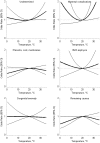Elevated outdoor temperatures and risk of stillbirth
- PMID: 27160765
- PMCID: PMC5837696
- DOI: 10.1093/ije/dyw077
Elevated outdoor temperatures and risk of stillbirth
Abstract
Background: The causes of stillbirth are poorly understood, including whether elevated outdoor temperatures increase risk. We assessed the relationship between elevated ambient temperatures and risk of stillbirth by gestational age and cause of death during warm months in a temperate region.
Methods: We performed a case-crossover study of 5047 stillbirths in continental Quebec, Canada, between the months of April through September from 1981 to 2011. Using data on maximum daily temperatures adjusted for relative humidity, we estimated associations with stillbirth, comparing temperatures before fetal death with temperatures on adjacent days. The main outcomes were stillbirth according to age of gestation (term, preterm), and cause of death (undetermined, maternal, placenta/cord/membranes, birth asphyxia, congenital anomaly, other).
Results: Elevated outdoor temperatures the week before the death were more strongly associated with risk of term than preterm stillbirth. Odds of term stillbirth for temperature 28 °C the day before death were 1.16 times greater relative to 20 °C (95% confidence interval, CI 1.02-1.33). Elevated outdoor temperature was associated with stillbirth due to undetermined and maternal causes, but not other causes. Compared with 20 °C, the odds of stillbirth at 28 °C were 1.19 times greater for undetermined causes (95% CI 1.02-1.40) and 1.46 times greater for maternal complications (95% CI 1.03-2.07).
Conclusions: Elevated outdoor temperatures may be a risk factor for term stillbirth, including stillbirth due to undetermined causes or maternal complications.
Keywords: Cause of death; gestational age; heat stress disorders; hot temperature; stillbirth.
© The Author 2016; all rights reserved. Published by Oxford University Press on behalf of the International Epidemiological Association
Figures


References
-
- Lawn JE, Blencowe H, Pattinson R. et al. Stillbirths: Where? When? Why? How to make the data count? Lancet 2011;377:1448–63. - PubMed
-
- Flenady V, Middleton P, Smith GC. et al. Stillbirths: the way forward in high-income countries. Lancet 2011;377:1703–17. - PubMed
-
- Green R, Sarovar V, Malig B, Basu R.. Association of stillbirth with ambient air pollution in a California cohort study. Am J Epidemiol 2015;181:874–82. - PubMed
Publication types
MeSH terms
Grants and funding
LinkOut - more resources
Full Text Sources
Other Literature Sources
Medical
Miscellaneous

